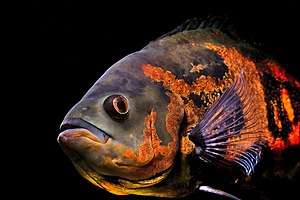Astronotus
Astronotus is a genus of South American fish from the family Cichlidae. There are two species in the genus (listed below), both of which are found in the Amazon Basin, while one of two also is found in the Paraná and Paraguay rivers. Astronotus species grow to 35 cm in size, and are monomorphic. They are opportunistic omnivores and consume a range of smaller fish, fruits, nuts, crustaceans, mollusks and other invertebrates in the wild.
| Astronotus | |
|---|---|
 | |
| Oscar (A. ocellatus) | |
| Scientific classification | |
| Kingdom: | Animalia |
| Phylum: | Chordata |
| Class: | Actinopterygii |
| Order: | Cichliformes |
| Family: | Cichlidae |
| Subfamily: | Cichlinae |
| Tribe: | Astronotini Hoedeman, 1947 |
| Genus: | Astronotus Swainson, 1839 |
| Type species | |
| Lobotes ocellatus Agassiz, 1831 | |
One species, the oscar (Astronotus ocellatus), is popular in the aquarium trade. A. ocellatus forms monogamous pairs which spawn in the open, typically on a flattened stone or in a shallow depression. The juvenile colouration is different from that of the adult and may aid in camouflage of the fry.
In contrast, Astronotus crassipinnis is rarely exported and is not seen often in the aquarium trade.
In some classifications the Astronotus is the sole genus in the monogeneric tribe Astronoti of the subfamily Cichlinae.[1]
Species
There are currently two recognized species in this genus:[2]
- Astronotus crassipinnis (Heckel, 1840)
- Astronotus ocellatus (Agassiz, 1831) (Oscar)
References
- Wm. Leo Smith; Prosanta Chakrabarty; John S. Sparks (2008). "Phylogeny, taxonomy, and evolution of Neotropical cichlids (Teleostei: Cichlidae: Cichlinae)". Cladistics. 24 (5): 624–641. doi:10.1111/j.1096-0031.2008.00210.x. Abstract
- Froese, Rainer and Pauly, Daniel, eds. (2013). Species of Astronotus in FishBase. February 2013 version.
Further reading
- Colatreli, Meliciano, Toffoli, Farias, and Hrbek (2012). Deep phylogenetic divergence and lack of taxonomic concordance in species of Astronotus (Cichlidae). International Journal of Evolutionary Biology 2012. doi:10.1155/2012/915265